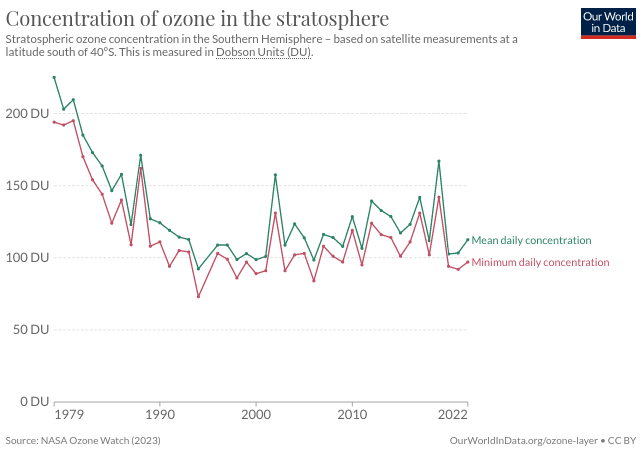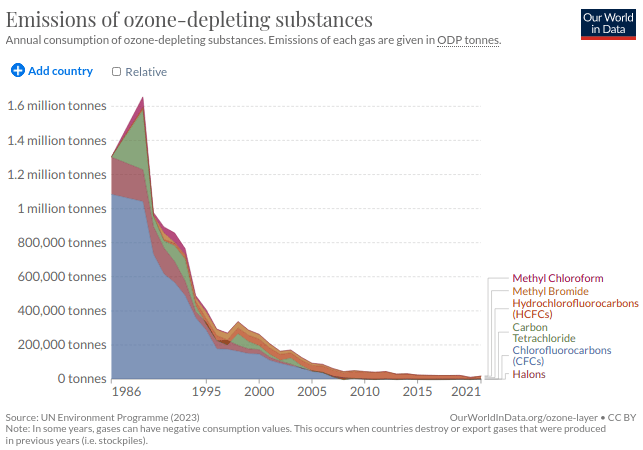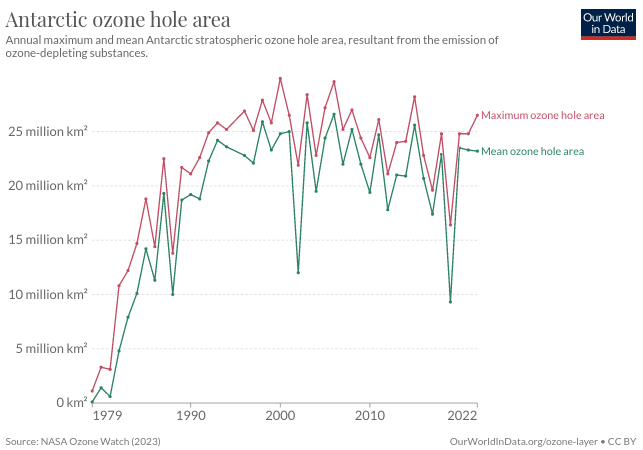3 Answers sorted by
*
759What a provocative question - I have a feeling this could be an equally useful historical test case as the invention of the airplane and hot air balloon. There might be an even larger number of historical contingencies here than it seems at first glance.
It seems important to split the question into two parts:
- If widespread CFC use had preceded atmospheric monitoring, would we have destroyed the ozone layer?
- Edit: My original take was "Based on the speed at which high emissions destroyed the ozone layer, it seems like the answer is "yes." This was under-researched, because as Simon explicitly notes in comments, ozone would not go to zero but would instead reach an equilibrium point. How low the ozone layer would have gotten with unrestricted use of CFCs (which also are extremely potent greenhouse gases), and how bad would the effects have been at a given level of depletion, is not addressed here. It requires a higher level of expertise and more time to research than I have. My brief effort, sources in comments, showed that even the unrealistic worst-case scenario simulations (3% annual growth in CFC usage over ~130 years resulting in something like 46x the amount used relative to reality) would result in a lot of skin cancer and a lot of plant die-off, but not the apocalypse. Hard to imagine we would not have figured this out, motivated by the effects we were seeing. Thanks Simon for spurring me to look at this.
- What are the interrelated structural forces that drove commercialization of CFCs, atmospheric monitoring, and environmental regulation? How lucky vs. overdetermined was it that we'd catch the destruction of the ozone layer in time?
It took 10 years from mass residential refrigeration to lead to use of CFCs. It took another half-century to detect atmospheric CFCs and the damage they were causing. Bans started taking effect almost immediately due to environmentalist groundwork on pesticides that had been taking place over the previous 15 years.
If I had to try and make some sense out of this, it took a lot of economic growth and refinement in refrigeration technology and chemistry to motivate mass use of CFCs. That same growth and use of chemistry was wrecking people's health and the environment, often in obvious ways, and was motivating other scientists to study the issue and work toward legislation. This was very difficult because the chemical industry was fighting it every step of the way, but they were incredibly successful.
Based on this, I'd really like to understand more about how it was that the environmentalist movement was so organized and potent in this time period. Was it that the problems they were dealing with, like bird deaths, were more obvious? Was it just that we had zero regulation and it was obvious that on the margin, we'd like to have more? Was it that there were actually plenty of good alternatives to things like DDT and CFCs? Is a broken clock right twice a day?
In any case, I have to give a lot of credit to the scientists, popularizers, and politicians who confronted this issue head-on and in a very timely manner. Most of my experience with politics has been one of frustrating impotency, and it's been interesting to review a case where we got it right.
Here's a timeline based entirely on Wikipedia articles and Our World In Data:
- The first synthesis of a CFC, carbon tetrachloride, was conducted by Michael Faraday in 1820.
- The first gas absorption refrigeration system was invented by Edward Toussaint in 1859, but used ammonia dissolved in water. Sulfur dioxide and methyl chloride came to be used as well until the discovery of CFCs as refrigerants by Thomas Midgley.
- CFCs were first used for niche applications starting in the late 1800s
- The ozone layer was discovered in 1913 by Charles Fabry and Henri Buisson using the Fabry–Pérot interferometer.
- Mass introduction of modern residential refrigeration took place from 1914-1922.
- In the late 1920s, Frigidaire started seeking a nontoxic, nonflammable, non-explosive refrigerant. Thomas Midgley, the same guy who put lead in gasoline, led the research, focusing on highly volatile yet chemically inert substances, properties possessed by alkyl halides. They synthesized Freon. With other CFCs, Freon rapidly displaced other gases as refrigerants.
- From the 1940s-late 50s, Rachel Carson, who would later author Silent Spring, was getting concerned about mass spraying of synthetic pesticides.
- From WWII through the 1960s, new applications for CFCs were discovered, including in aircraft and in fire-fighting.
- In 1958, Rachel Carson's immediate motivation for writing Silent Spring came when a friend wrote a letter to the Boston Herald describing bird deaths around her property due to DDT, and she connected with a large group of scientists who were already studying the issue. She met a lot of resistance from the USDA's Agricultural Research Service and chemical industry representatives.
- From 1957-1959, crops of US cranberries were found to contain high levels of the herbicide aminotriazole, halting sale of cranberry products.
- The modern environmentalist movement emerged in the 1960s, with an important motivator being the publication of Silent Spring by Rachel Carson in 1962 (she wrote it while suffering from metastatic breast cancer, and died in 1964).
- In 1969, the National Environmental Policy Act was signed into law, which established the Council on Environmental Quality, which would urge passing the Toxic Substances Control Act.
- In 1970, the EPA was founded.
- In 1971, the Toxic Substances Control Act was introduced to Congress, but would not be passed until 1976.
- CFCs in the atmosphere were discovered in 1973 by James Lovelock, using the electron capture detector he'd invented in 1957. He concluded that there were no damaging effects on the atmosphere.
- The damaging effects of CFCs on the ozone layer were discovered in 1974 by F. Sherwood Rowland and Mario Molina. The same inertness and volatility that makes them great refrigerants lets them get into the upper atmosphere and stay there long term, where sunlight can break them down and cause them to react with ozone.
- Commercial CFC manufacturing was banned under the Toxic Substances Control Act in 1976, the first year the law came into effect. In the graphs below, note that the graph of emissions starts in 1986, while the ozone hole and concentration graphs start earlier, in 1979.

- The ozone hole was discovered in 1982.
- In 1987, the Montreal Protocol, considered by some to be the most successful international agreement to date, phased out CFCs globally, with a full ban taking effect in 1989. Ozone levels stabilized in the mid-90s and started recovering in the 2000s. The ozone layer should regenerate by 2045 and the ozone hole is expected to reach pre-1980 levels by 2075.
- Modern refrigerators use HFC-134a (a less-bad greenhouse gas) and R-600a (explosive and flammable) replaced Freon and other CFCs as refrigerants.
Based on the speed at which high emissions destroyed the ozone layer, it seems like the answer is "yes."
evidence/argument needed? Note that outside Antarctica, ozone gets regenerated by UV from the sun, so it's going to be an equilibrium condition where that is balanced with ozone destruction from chlorine, and not zero.
As a follow-on, I stumbled across a counterfactual simulation study (2009), which found that if CFCs had continued to be used at half the rate use was growing at in the early 1970s, 17% of ozone would be depleted by 2020 and 67% by 2065, to 50-100 DU down from 300-500 DE in 1960.
Another counterfactual study from 2021 gave a worst-case scenario finding (using similar metrics of CFC use as in other older studies) for the effects on plant life:
As a result of these large reductions in net carbon uptake, global terrestrial biomass decreases from 340 Gt C (1976–2005) to 245 Gt C (200–285 Gt C) by the end of the century (not shown).
So a 30% loss in terrestrial biomass. But of course this must be very hard to simulate with high confidence and it represents continuous 3% year on year growth in CFCs through 2099, which is something like a 46x increase from 1970-2099. It seems both unlikely to me that in 130 years of massive plant die-off and increases in skin cancer, that the entire global scientific community would have just failed to figure this one out.
Does anyone have any idea what caused the two large positive spikes in ozone concentration in roughly 2002 and 2020?
The incidence with the dot com boom and COVID might be a coincidence, but it suggests that maybe some other product of our everyday economy is adversely impacting the ozone layer.
Mass introduction of modern residential refrigeration took place from 1914-1922.
What do you mean? Cooling food? I think that is a rounding error. A single wall AC has 10x as much freon as a refrigerator. Thus I think the bulk of the freon came later and there was not so long a delay from deployment to discovery. But it should be possible to look up actual freon production.
I think the growth of air conditioning was contained by the cost of electricity, not freon. It's hard for me to imagine electricity cheap and widespread enough to allow refrigerators w...
See, shit like this is why I think that when Agent Smith says in the Matrix that 1999 was the peak of our human civilisation I think that might have been scarily accurate.
314
I did a little research and this seems to be true, at least if we restrict it to "If we had invented chloroflourocarbons in 1800, and used them as vigorously as we did in real life, we would have severely depleted animal and plant life outside the tropical zone." Our hypothetical air-conditioned Victorians would observe a steady increase in harmful ultraviolet light, spreading from the poles. But the cause would remain a mystery. In our timeline, the ozone layer depletion was discovered by satellite, but could have been detected from the ground if people had been measuring. So we wouldn't have to wait until spaceflight for it to be discovered. But the mechanism by which chloroflurocabons deplete ozone is quite beyond nineteenth century chemistry, and furthermore the ozone layer would not even be discovered until 1913. So they would have kept on using them for many decades. Our fifty years of use depleted the ozone layer over the poles (where it is thickest) by about twofold, but over the equator by only ten percent. In the other time line, it seems reasonable to extend this for 150 years, to a tenfold increase in CFC concentration. This would lead to roughly a ninety percent depletion over the poles and in the temperate zones, and a factor of two over the tropics. This would have catastrophic effects on all life on land or in the shallow ocean. Eventually the economy would collapse and CFC production would decrease, but since it lasts for many decades in the atmosphere, this would not get better for a long time.
93
Just wanted to say thanks so much to the fact checkers here! It's nice that I was able to update my half-baked thread with your more researched takes. Didn't expect my shower thought to blow up quite so much!


Link: https://twitter.com/tyler_m_john/status/1645377948952698881